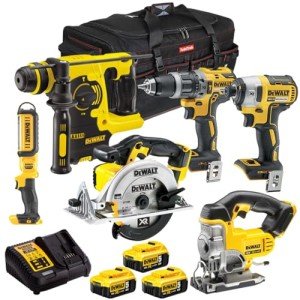9 . What Your Parents Teach You About Battery Powered Tool Set
페이지 정보
작성자 Carol 작성일 25-11-14 01:05 조회 2 댓글 0본문
Comprehensive Guide to Battery-Powered Tool Sets
In recent years, battery-powered tools have changed the way both experts and DIY lovers approach their projects. With their benefit and efficiency, battery-powered tool sets have actually ended up being a staple in workshops across the country. This post digs into the benefits of battery-powered tools, necessary parts, contrasts, and answers to some frequently asked questions.
Why Choose Battery-Powered Tool Sets?
Battery-powered tools offer many benefits over their corded counterparts:
Portability: Without the obstacle of a cord, battery-powered tools can be quickly transported and used anywhere.
Convenience: Quick setups get rid of the requirement for outlet gain access to, making them ideal for outdoor tasks.
Reduced Trip Hazards: The lack of cords permits for a much safer work area, especially in congested or messy environments.
Technological Advancements: Most contemporary Battery Powered Tool Set-powered tools include powerful lithium-ion batteries that offer longer runtimes and faster charging times.
Secret Components of a Battery-Powered Tool Set
A common battery-powered tool set might consist of numerous tools customized to meet the requirements of different projects. Below is a comprehensive table showcasing standard tools discovered in these sets:
| Tool | Function | Common Battery Voltage | Common Brands |
|---|---|---|---|
| Drill/Driver | For drilling holes and driving screws | 12V to 20V | DEWALT, Makita, Milwaukee |
| Circular Saw | For cutting wood, plywood, and other products | 18V to 20V | Bosch, Ryobi, Black+Decker |
| Reciprocating Saw | For demolition and rough cuts in numerous products | 18V | Porter-Cable, Hitachi |
| Effect Driver | For driving big screws/fasteners | 12V to 20V | Craftsman, Ridgid |
| Sander | For smoothing surface areas and completing wood | 12V to 20V | Ryobi, Milwaukee |
| Angle Grinder | For cutting and grinding metal, masonry, and tiles | 18V | Makita, DEWALT |
| Jigsaw | For elaborate cuts in wood, plastic, and metal | 12V to 20V | Black+Decker, Bosch |
Notable Features to Consider
When selecting a battery-powered tool set, several features can improve usability and performance:
Battery Life: Look for tools with lithium-ion batteries that supply longer runtimes and charge quickly.
Interchangeability: Some tool sets allow for battery compatibility throughout multiple tools, reducing the need for multiple batteries.
Weight: Consider the ergonomics; lighter tools can lower fatigue throughout substantial usage.
Durability: Robust building and protective functions (like dust and water resistance) ensure the durability of the tools.
Service warranty and Support: Good brand names usually offer service warranties that cover defects and offer customer assistance for queries.
Comparing Battery-Powered Tools to Corded Tools
The choice in between battery-powered and corded tools frequently comes down to individual choice and project requirements. Here's a comparison:

| Feature | Battery-Powered Tools | Corded Tools |
|---|---|---|
| Mobility | High - can be used anywhere | Minimal - requires proximity to Power Tool Sets outlets |
| Runtime | Minimal by battery life | Continuous as long as plugged in |
| Power Tool Bundle Output | Normally less effective than corded | Frequently more powerful |
| Upkeep | Requires battery care | Lower upkeep; more uncomplicated |
| Rate | Normally higher preliminary investment | More cost-effective for individual tools |
| Adaptability | Many multi-purpose tools readily available | Specialized tools available |
Best Practices for Using Battery-Powered Tool Sets
To make the most out of a battery-powered tool set, follow these best practices:
Charge Batteries Regularly: To make sure maximum battery life, avoid deep discharging and charge batteries after each usage.
Tidy Tools After Use: Keeping Build Your Own Tool Kit tools clean lowers wear and tear and can help preserve their life expectancy.
Shop Safely: Keep tools in a dry, safe location to prevent damage and make sure easy access.
Check Out User Manuals: Each tool may have specific operating guidelines or maintenance pointers; reading the handbook can conserve time and disappointment.
Frequently Asked Questions (FAQs)
1. How long do battery-powered tools last?
The life-span of battery-powered tools depends upon usage and maintenance however can last several years with correct care. Lithium-ion batteries usually last 2-3 years, depending on charging practices.
2. Can I use my battery-powered tools in cold weather condition?
Severe cold can impact battery performance. It's best to keep batteries at space temperature level when not in use and enable them to warm up before usage in cold conditions.
3. Are all battery-powered tools suitable with the same battery?
Not always. Battery compatibility frequently depends upon the brand and particular tool design. It's necessary to confirm compatibility before purchasing extra tools.
4. How do I keep lithium-ion batteries?
To preserve lithium-ion batteries, avoid complete discharges, keep them cool, and charge them after use. It's also recommended to utilize the manufacturer's battery charger.
5. What are the most essential tools for a novice?
For novices, a drill/driver, circular saw, and impact driver are often the most vital tools to begin with, as they cover a broad range of standard tasks.
Battery-powered tool sets have reinvented how we approach traditional jobs, offering a mix of benefit and efficiency. Whether for expert trades or DIY home enhancements, these tools deal with diverse project needs. By comprehending the functions, parts, and best practices connected with battery-powered tools, users can optimize their effectiveness and productivity. Armed with this thorough guide, both beginners and experienced professionals can now make notified decisions when choosing their next tool set.
댓글목록 0
등록된 댓글이 없습니다.



